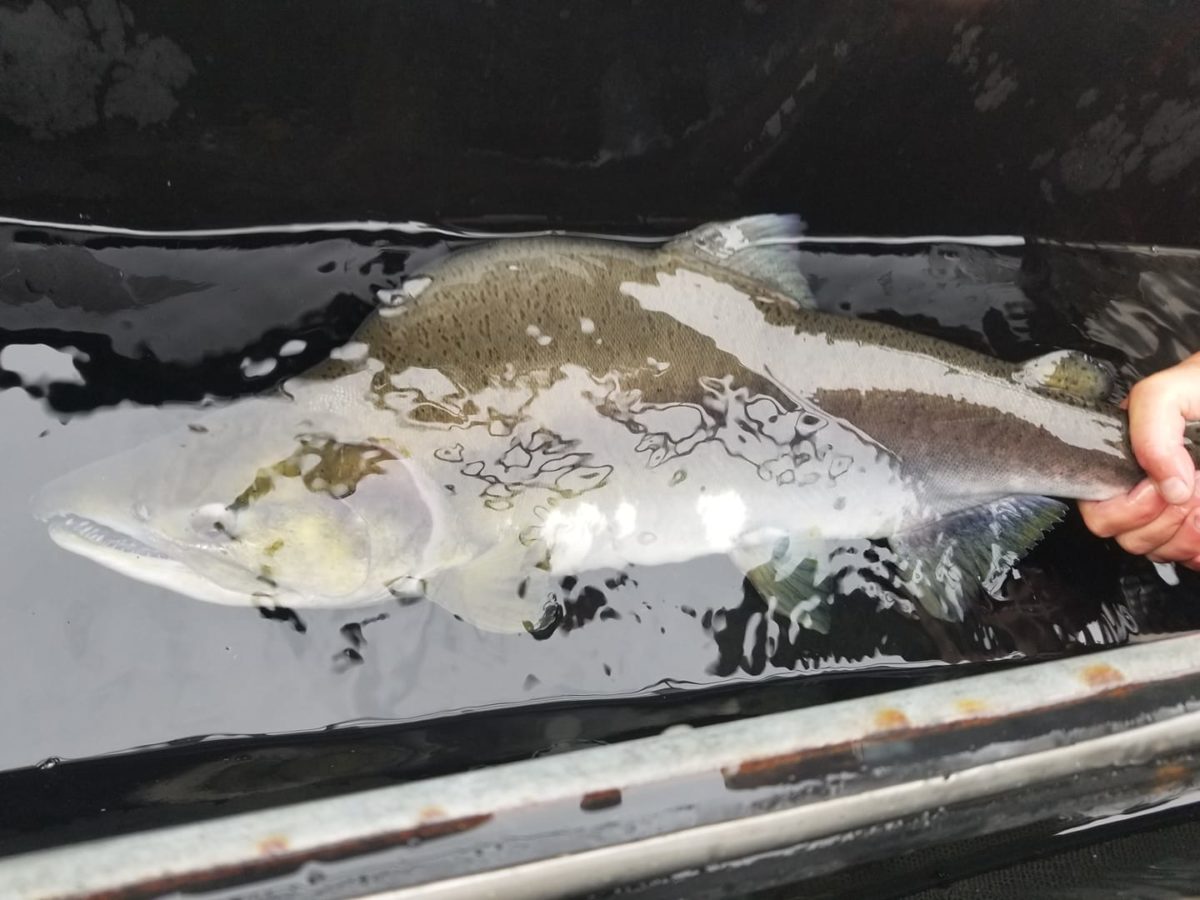
Pink Salmon Observed In Wenatchee River; Huge Coho Return To Upper Columbia
Lower Granite Dam on Southeast Washington’s Snake River isn’t the only peculiar place pinks have popped up this fall.
A handful of humpies have also been helped around a diversion dam on the lower Wenatchee River.

Bill Towey, a biologist with Chelan County PUD, says that four or five pinks have been passed around a fish collection station at Dryden, between Leavenworth and Wenatchee.
He says it’s led to “a lot of head scratching” about what the odd-year salmon might be up to.
Looking for a shortcut over Stevens Pass back to the Skykomish, far more well known for pinks?
The first fish there led to a story in the Wenatchee World by Julia Pinnix, a visitor services manager for the U.S. Fish and Wildlife Service’s Leavenworth Fisheries Complex of hatcheries, who wrote that the station foreman recalled seeing only two other pinks in the seven years he’d worked there. But she also stated that a researcher who looked into tribal fisheries in the Wenatchee area reported that the species at one point migrated upstream as far as Icicle Creek.
PUD’s Towey does say that pinks have more of a “propensity” for straying than their cousins in the North Pacific and perhaps it’s just a function of a few of 2021’s large run to Pugetropolis streams missing the left turn at the mouth of the Strait of Juan de Fuca.
Indeed, the biggest returns to the Columbia system have all occurred in odd years. Per Fish Passage Center data, the 310 counted at Bonneville Dam on the Lower Columbia this year is the fifth most on record, after 2011’s record 3,828, 2003’s 637, 1991’s 550 and 2013’s 508. Outside of 1991, all were strong to very strong years for Puget Sound pinks.
Of 2021’s 310 at Bonneville, 43 made it through the gorge to McNary Dam, FPC counts show, and five took a right into the Snake, based on the count at Lower Monumental, the second dam on the river (there’s a goose egg in Ice Harbor’s pink column).
The one that arrived at Lower Granite sparked an article in the Lewiston Tribune by outdoor reporter Eric Barker.
Back on the Mid- to Upper Columbia, no pinks were recorded at Priest Rapids or Wanapum Dams above the Columbia’s Hanford Reach, but 10 were tallied at Rock Island Dam, not far below the mouth of the Wenatchee, and four have also finned on up to Rocky Reach Dam, according to FPC.
Washington is essentially the southern edge of today’s range of pinks, a species that typically sticks to shorter rivers with saltwater estuaries.. Unlike most Chinook, coho, sockeye and steelhead, they spend the vast bulk of their two short years of life in marine waters.
Well, except for a handful of pinks that have now swam 500 miles up the Columbia and another dozen or so miles up the Wenatchee to Dryden.
Speaking of Dryden, the fish station – which is located where an irrigation canal branches off the Wenatchee – is used by the Yakama Nation to collect coho for broodstock programs that are restoring the salmon stock to the Upper Columbia region, where the species was essentially extirpated in the 1900s.
And speaking of coho, it appears that the 54,720 adults counted at Rock Island Dam so far this year is already the most there since counting began in 1977, as well as six times the 10-year average through October 6 and more than three times the annual average over the last decade.
It’s a remarkable turnaround from as recently as the mid-1990s, when there were back-to-back-to back years with no coho at Rock Island.
Beginning in 1996 the Yakamas began utilizing Lower Columbia silvers to develop a Mid-Columbia broodstock.
And with that program working, fisheries have been opened up, including the Columbia from Priest Rapids to Wells Dams and the Icicle this season.
Dave Graybill, the Fishin’ Magician and former state Fish and Wildlife Commissioner, reported hooking an Icicle coho a day last week in a report he posted Friday, and in a phone call this afternoon said the fishing will be much better when it rains just enough to color up the creek.
“It’s a very welcome new opportunity to have in our region,” said Graybill, who noted that it’s now been five seasons without steelhead fishing in the Upper Columbia due to poor returns.
The technique for Icicle coho is pretty simple, he says, pointing to twitching, although the standard-sized jigs are a bit on the heavy side for the low, clear conditions.
Graybill says he’s been using Mack’s Rock Dancers in cerise and purple, but you could also try midsized Blue Fox spinners in pinks, oranges and other bright colors, or maybe roll-cast bullethead flies on sink-tip fly lines.
Even after swimming so far from the sea, these salmon “cut beautifully,” he adds.
Weird and good things are happening in the Upper Columbia!
